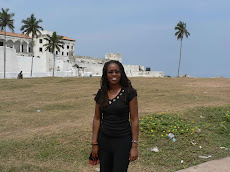

I replied, “Well, there are street lights and I live next to the hospital and a mining training college that has flood lights and…”
“Tam,” she then politely interrupted, “can you see all the stars throughout the sky like you could in Khorixas?”
“Yes,” I unhesitatingly answered.
“Then," she directed, "you don’t have lights in Keetmanshoop.”
“Oh,” I humbly conceded.
Though a more established town, Keetmanshoop and Khorixas have many similarities. I am still in a fairly isolated environment, without many unnatural obstructions like artificial lights, as my mother so keenly points out, and with many soil-eroded dirt roads. Keetmanshoop, with a larger population, has more available resources. There are actual bank branches (not one meager satellite office/room), two large grocery stores (and many little butcheries and tuck shops), and extended operating hours for services (everything does not close at 17h00). It still cannot be classified as a “city,” though, and there are many conveniences that I must still forego. In other words, no KFC! (big sigh, I’m serious, big sigh)
Four neighborhoods, in addition to the “central business district-CBD” (their terminology, not mine), comprise the town of Keetmanshoop. I live in Kronlein, located southwest of the CBD. Kronlein was the area reserved for Coloureds (not classified as black, not classified as white) during apartheid. To the north of Kronlein is Tseiblaagte, the area where the Nama people were located during apartheid (the Nama people are very light-skinned Africans whose ancestors are from one of the earliest tribes on record in Namibia). Close to the CBD is the newer residential area of Noordhoek. And east of the CBD is Westdene, a well-developed residential area that accommodated whites during the apartheid-era. With the exception of Tseiblaagte, most areas and schools are now integrated. Almost all of my colleagues are from this area and attended school during the segregation period. The school pictured with me and the nun, for example, used to be called the Roman Catholic Coloured School (now Don Bosco Primary School), when the manager of the Teachers’ Resource Centre was a student there. There is a private school, Keetmanshoop Private School, that opened in 1994, after the end of apartheid, which I believe is 100% white.
Afrikaans is the predominant language spoken in this area; although, Nama (the same as the Damara language of Khoekhoegowab, with the four distinctive clicks, spoken in Khorixas) is also spoken. I have spent a few weekends with colleagues who have been helping me practice both. I find it funny when I am being corrected, but I just keep repeating the same error because of the fact that certain sounds/pronunciations simply do not exist in the English language. I’ll get it; it just takes time, practice, and patience.
My home is quaint, with many new country-style wood furnishings (I'll post pix later). I also have a good deal of privacy (almost too private) because my house is enclosed in a gated area and I do not have any housemates. What is even more exciting is that my home is a stone’s throw away from the learning centre I was sent here to manage. This is a good thing because Keetmanshoop records the country’s hottest temperatures during the summer (NOW). I am warned, though, that Keetmanshoop also records the country’s coldest temperatures in the winter (my fleece and velvet blankets are waiting in the closet).
I feel very safe here; although, on one of my school visits last week, I witnessed my first fight, complete with a young boy armed with a steak knife, yes, a steak knife. Fighting with knives is reportedly a common practice around here. I am told that it is mainly around the shebeens (bars), usually at nights and on weekends, and mainly in the Tseiblaagte neighborhood (although none of those criteria were met for the fight I saw - it was at a school, during the day, in Kronlein). My impression is that the children are fairly bored; it’s a bigger town so not everyone knows everyone; there are not many social and cultural outlets; and they get into trouble because they are fairly disengaged in their schooling. Everyone seemed drawn to the commotion, probably because they are also bored and looking for excitement, however false and misguided. I was disturbed that I was one of the few adults in the masses that was actually trying to diffuse the situation and disperse the crowd. Even the security guard seemed unaware of exactly what to do, so she just did nothing.
“A child in sport is a child out of court,” read the back of a t-shirt worn by a teacher pictured with a few of his learners at this weekend’s athletics tournament. I somewhat agree. Organized sports and arts programs are constructive ways of channeling the energy, competitive spirit, and creative/expressive talents of children. I was glad to see so many competitors and spectators at the event (even though the busted bleachers made me feel like any minute I would fall through).Ooh, and I even learned a few school chants/cheers in Afrikaans. “Es lekker om de Suiderlig de vies” (It’s good to be from Suiderlig HS) (Too bad I didn’t learn how to spell it).
Keetmanshoop is some of the same and a lot of the new. Still dusty, still hot, still dependent on the sounds of birds and laughing children to alert me to the start of the day. But much bigger, more challenges, and more opportunities to make an impact. I miss the familiar and loving faces of the community I served in Khorixas, but each new experience is welcomed.
The title is an attempt to say, "My house is near the office." in Afrikaans.







.jpg)
lovely work you do..and that i like
ReplyDelete